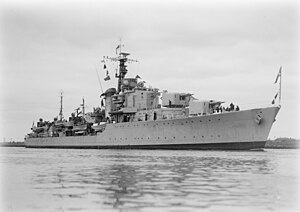HMAS Anzac (D59)
 HMAS Anzac
| |
| History | |
|---|---|
| Namesake | The Australian and New Zealand Army Corps |
| Builder | Williamstown Naval Dockyard |
| Laid down | 23 September 1946 |
| Launched | 20 August 1948 |
| Completed | 22 March 1951 |
| Commissioned | 14 March 1951 |
| Decommissioned | 4 October 1974 |
| Reclassified | Training ship (1961) |
| Motto | "United We Stand" |
| Honours and awards | |
| Fate | Sold for scrap, 24 November 1975 |
| General characteristics | |
| Class and type | Battle-class destroyer |
| Displacement |
|
| Length |
|
| Beam | 41 ft (12 m) |
| Draught | 21 ft 11.5 in (6.693 m) |
| Propulsion | 2 Admiralty 3-drum boilers, Parsons geared turbines, 50,000 shp , 2 shafts |
| Speed | 31 knots (57 km/h; 36 mph) |
| Complement |
|
| Armament |
|
HMAS Anzac (D59) was a
Design and construction
Anzac was built to the British

The main armament of Anzac consisted of four
Anzac was
Operational history
On 30 July 1951, Anzac left Australian waters for her first deployment to the
Her first Korean tour completed, Anzac escorted HMS Glory to Sydney, where they arrived on 20 October.
For her two tours, Anzac was awarded the
During late 1953 and early 1954, Anzac was assigned to Queen Elizabeth II's coronation tour.[3] The destroyer carried the Queen, the Duke of Edinburgh, and other members of the Royal Party during visits to locations in Queensland, then Papua and New Guinea.[3]
Anzac operated during the Malayan Emergency. Following an overhaul of the RAN battle honours system, the destroyer was retroactively awarded a second honour to recognise this: "Malaya 1956".[6][9]
Between 1956 and 1959, the destroyer was deployed on several occasions to serve with the Far East Strategic Reserve.[3]
In September 1960, Anzac was performing gunnery exercises with sister ship HMAS Tobruk.[10] A malfunction in Anzac's gun direction equipment negated the deliberate 6° mis-aiming of her guns, with the resulting shell hitting Tobruk and doing enough damage to the destroyer to make repairs uneconomical.[10] Two of Anzac's personnel were charged by the Naval Board,[10] while Tobruk was decommissioned a month later.
In March 1961, Anzac completed conversion into a
During February and March 1963, Anzac served as escort for Queen Elizabeth II and the
Decommissioning and fate
Anzac was berthed at
Citations
- ^ a b c d e f g h i j k Cassells, The Destroyers, p. 10
- ^ Cassells, The Destroyers, p. 9
- ^ a b c d e f g h i j k l m n o p q r Perryman & Djokovic, Ships Named Anzac
- ^ Cassells, The Destroyers, pp. 10–11
- ^ a b c d e f g h i j Cassells, The Destroyers, p. 11
- ^ a b "Royal Australian Navy Ship/Unit Battle Honours" (PDF). Royal Australian Navy. 1 March 2010. Archived from the original (PDF) on 14 June 2011. Retrieved 23 December 2012.
- ^ Cassells, The Destroyers, pp. 11–12
- ^ Perryman, The Origin of RAN Squadron and National Insignia
- ^ "Navy Marks 109th Birthday With Historic Changes To Battle Honours". Royal Australian Navy. 1 March 2010. Archived from the original on 13 June 2011. Retrieved 23 December 2012.
- ^ a b c Frame, Where Fate Calls, pp 36–7
- ^ a b Cassells, The Destroyers, p. 12
- ^ Frame, Where Fate Calls, p. 37
- ^ Nott & Payne, The Vung Tau Ferry, p. 170
- ^ Grey, Up Top, p. 106
- ^ a b Nott & Payne, The Vung Tau Ferry, p. 173
References
Books
- Cassells, Vic (2000). The Destroyers: Their Battles and Their Badges. East Roseville, NSW: Simon & Schuster. OCLC 46829686.
- OCLC 26806228.
- OCLC 39074315.
- Nott, Rodney; Payne, Noel (2008) [1994]. The Vung Tau Ferry: HMAS Sydney and Escort Ships (4th ed.). Dural, NSW: Rosenberg. OCLC 254773862.
Journal and news articles
- Perryman, John; Djokovic, Petar (February 2015). "Ships Named Anzac". Semaphore. 2015 (2). Sea Power Centre Australia. Retrieved 4 May 2015.
Websites
- Perryman, John. "The Origin of RAN Squadron and National Insignia". History – Traditions. Royal Australian Navy. Retrieved 31 July 2014.
Further reading
- Hodges, Peter (1971). Battle Class Destroyers. London: Almark Publishing. ISBN 0-85524-012-1.
